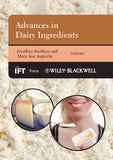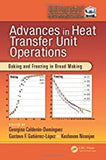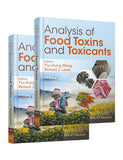Encapsulation Technologies and Delivery Systems for Food Ingredients and Nutraceuticals edited by Nissim Garti
Encapsulation Technologies and Delivery Systems for Food Ingredients and Nutraceuticals
edited by Nissim Garti
Encapsulation Technologies and Delivery Systems for Food Ingredients and Nutraceuticals is a comprehensive guide to current and emerging techniques.
Part One: Requirements for Food Ingredient and Nutraceutical Delivery Systems addresses key requirements for food ingredient and nutraceutical delivery systems, discussing challenges in system development and analysis of interaction with the human gastrointestinal tract.
Part Two: Processing Technology Approaches to Produce Encapsulation and Delivery Systems focuses on processing technologies for encapsulation and delivery systems. Covers spray drying, cooling and chilling, coextrusion, fluid bed microencapsulation, microencapsulation methods based on biopolymer phase separation, and gelation phenomena in aqueous media.
Part Three: Physicochemical Approaches to Produce Encapsulation and Delivery Systems investigates physicochemical approaches to the production of encapsulation and delivery systems, including the use of micelles and microemulsions, polymeric amphiphiles, liposomes, colloidal emulsions, organogels and hydrogels.
Part Four: Characterization and Applications of Delivery Systems discusses characterization and applications of delivery systems, providing industry perspectives on flavor, fish oil, iron micronutrient and probiotic delivery systems.
CONTENTS
Part 1: Requirements for Food Ingredient and Nutraceutical Delivery Systems
1. Requirements for food ingredient and nutraceutical delivery systems
2. Challenges in developing delivery systems for food additives, nutraceuticals and dietary supplements
- Classes of food ingredients
- Formulating and designing microencapsulation systems for food additives, nutraceuticals and dietary supplements
- Encapsulated ingredients and applications
- The market for encapsulated ingredients and nutraceuticals
3. Interaction of food ingredient and nutraceutical delivery systems with the human gastrointestinal tract
- Model systems
- The human gastrointestinal tract
- Bioactive delivery system design
- Implications of research on functional food development
Part 2: Processing Technology Approaches to Produce Encapsulation and Delivery Systems
4. Spray drying, freeze drying and related processes for food ingredient and nutraceutical encapsulation
- Principles and technical considerations of spray drying encapsulation
- Applications of spray drying for food ingredient and nutraceutical encapsulation
- Storage stability of spray dried encapsulated products and limitations of spray drying encapsulation
- Principles and technical considerations of freeze drying encapsulation
- Applications of freeze drying for food ingredient and nutraceutical encapsulation
- Storage stability of freeze encapsulated products and limitations of freeze drying encapsulation
5. Spray cooling and spray chilling for food ingredient and nutraceutical encapsulation
- Spray-cooling and spray-chilling technologies
- Formulations and applications
6. Coextrusion for food ingredients and nutraceutical encapsulation: principles and technology
- Principles of coextrusion
- Coextrusion technologies
- Formulations and applications
7. Fluid bed microencapsulation and other coating methods for food ingredient and nutraceutical bioactive
- Definition of microencapsulation and fluidized bed coating
- Technology and machine design
- Particle characteristics, process parameters and applications of fluid bed microencapsulation
8. Microencapsulation methods based on biopolymer phase separation and gelation phenomena in aqueous media
- Candidate biopolymer shell materials
- Biopolymer properties and microcapsule formation
- Encapsulation technology
- Traditional versus emerging complex coacervation encapsulation procedures
Part 3: Physicochemical Approaches to Produce Encapsulation and Delivery Systems
9. Micelles and microemulsions as food ingredient and nutraceutical delivery systems
- Microemulsions: definitions and terminology
- Water-in-oil(W/O) and oil-in-water(O/W) microemulsions
- Solubilization of nutraceuticals in U-type microemulsions
- Microemulsion processes and applications
10. Polymeric amphiphiles as food ingredient and nutraceutical delivery systems
- Classification, composition, structure, properties and self-assembly of polymeric amphiphiles: Proteins and peptides
- Classification, composition, structure, properties and self-assembly of polymeric amphiphiles: Polysaccharides, oligosaccharides and polysaccharide-protein conjugates
- Binding and co-assembly of biopolymeric amphiphiles and nutraceuticals
- Mechanisms of solubilization and protection of hydrophobic nutraceuticals by biopolymeric amphiphiles
- Applications and future trends of biopolymeric amphiphiles for encapsulation and delivery of food ingredients and nutraceuticals
11. Liposomes as food ingredients and nutraceutical delivery systems
- Formation and structures of liposomes
- Liposome preparation methods
- Characterisation of liposomes
- Encapsulation by liposomes
- Liposome stability
- Liposome applications in food systems
- Stability of liposomes to gastrointestinal environment
12. Colloidal emulsions and particles as micronutrient and nutraceutical delivery systems
- Physico-chemical stability, texture, taste and flavour
- Appearance of dispersions in food products
- Bioavailability of functional ingredients
- Applications: overview of minerals and vitamins
- Applications: vitamin A
- Applications: vitamins D, E and K
- Nutraceuticals: carotenoids
- Nutraceuticals: water soluble polyphenols
- Nutraceuticals: water insoluble polyphenols
- Alkaloids and other photochemicals
13. Structured oils and fats (organogels) as food ingredient and nutraceutical delivery systems
- Research into organogelation as food ingredient and nutraceutical delivery systems
- Nutraceuticals and their use in organogels
- Delivery of carotenoids: lycopene and β-carotene
- Health effects and delivery of phytosterols
14. Hydrogel particles and other novel protein-based methods for food ingredient and nutraceutical delivery systems
- Food grade polysaccharides and proteins for hydrogel formation
- Development of polysaccharide and protein based hydrogels: physical crosslinking approach
- Development of polysaccharide and protein based hydrogels: chemical crosslinking approach
- Polysaccharide and protein based hydrogels
- Diffusion as a controlled-release mechanism
- Degradation as a controlled-release mechanism
- Other controlled-realease mechanisms
- Applications in food science
Part 4: Characterization and Applications of Delivery Systems
15. An industry perspective on the advantages and disadvantages of different flavour delivery systems
- Physical chemistry of flavor delivery systems: interfaces in emulsion-based delivery systems
- Barrier properties and permeation in core/shell delivery systems
- Molecular weight distributions in glassy systems
- Biopolymers
16. An industry perspective on the advantages and disadvantages of different fish oil delivery systems
- Health benefits associated with long chain omega-s
- Fish oil delivery systems used in industry
- Emerging strategies and technologies
17. An industry perspective on the advantages and disadvantages of iron micronutrient delivery systems
- Delivery systems of iron
- Criteria for selection of food product, iron compound and delivery system
- Application of iron delivery systems in dry food products
- Application of iron delivery systems as simulated rice and food sprinkles
- Application of iron delivery systems in dairy products and aqueous products
18. Properties and applications of different probiotic delivery systems
- Microencapsulation techniques: physical methods
- Microencapsulation techniques: chemical methods (hydrocolloid gel methods)
- Supporting materials
- Special treatment
- Application of microencapsulated probiotics in food products
Index


















